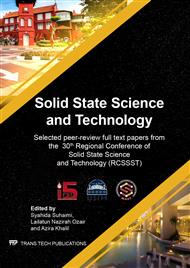[1]
Z.-G. Zhang, S. Zhang, J. Min, C. Chui, J. Zhang, M. Zhang, Y. Li, Conjugated side-chain isolated polythiophene: Synthesis and photovoltaic application, Macromolecules, 45 (2011) 113-118.
DOI: 10.1021/ma201718x
Google Scholar
[2]
Y. Zhu, S. Xu, L. Jiang, K. Pan, Y. Dan, Synthesis and characterization of polythiophene/titanium dioxide composites, Reactive and Functional Polymers, 68 (2008) 1492-1498.
DOI: 10.1016/j.reactfunctpolym.2008.07.008
Google Scholar
[3]
J. Lee, D. Kim, C. Kim, Synthesis of soluble polypyrrole of the doped state in organic solvents, Synthetic Metals, 74 (1995) 103-106.
DOI: 10.1016/0379-6779(95)03359-9
Google Scholar
[4]
X. Zhang, J. Zhang, W. Song, Z. Liu, Controllable synthesis of conducting polypyrrole nanostructures, The Journal of Physical Chemistry B, 110 (2006) 1158-1165.
DOI: 10.1021/jp054335k
Google Scholar
[5]
A. Wu, H. Kolla, S.K. Manohar, Chemical synthesis of highly conducting polypyrrole nanofiber film, Macromolecules, 38 (2005) 7873-7875.
DOI: 10.1021/ma051299e
Google Scholar
[6]
L.P. Vernon, G.R. Seely, The chlorophylls, Academic Press, (2014).
Google Scholar
[7]
R.D. Willows, Chlorophylls, Annual Plant Reviews, (2018) 23-56.
Google Scholar
[8]
J. Roncali, Conjugated poly (thiophenes): synthesis, functionalization, and applications, Chemical Reviews, 92 (1992) 711-738.
DOI: 10.1021/cr00012a009
Google Scholar
[9]
C. Li, H. Bai, G. Shi, Conducting polymer nanomaterials: electrosynthesis and applications, Chemical Society Reviews, 38 (2009) 2397-2409.
DOI: 10.1039/b816681c
Google Scholar
[10]
V. Saxena, B. Malhotra, Prospects of conducting polymers in molecular electronics, Current Applied Physics, 3 (2003) 293-305.
DOI: 10.1016/s1567-1739(02)00217-1
Google Scholar
[11]
P. Vallat, J.-P. Lamps, F. Schosseler, M. Rawiso, J.-M. Catala, Quasi-controlled polymerization through a nickel catalyst process of a functionalized thiophene monomer: kinetic studies and application to the synthesis of regioregular poly (thiophene-3-acetic acid), Macromolecules, 40 (2007) 2600-2602.
DOI: 10.1021/ma0615506
Google Scholar
[12]
T. Wu, L. Wang, Y. Zhang, S. Du, W. Guo, M. Pei, Electrochemical synthesis of poly (3-thiophene acetic acid) nanowires with water-soluble macromolecule templates, RSC Advances, 5 (2015) 16684-16690.
DOI: 10.1039/c4ra17078d
Google Scholar
[13]
A.F. Diaz, J.I. Castillo, J. Logan, W.-Y. Lee, Electrochemistry of conducting polypyrrole films, Journal of Electroanalytical Chemistry and Interfacial Electrochemistry, 129 (1981) 115-132.
DOI: 10.1016/s0022-0728(81)80008-3
Google Scholar
[14]
E. Genies, G. Bidan, A. Diaz, Spectroelectrochemical study of polypyrrole films, Journal of Electroanalytical Chemistry and Interfacial Electrochemistry, 149 (1983) 101-113.
DOI: 10.1016/s0022-0728(83)80561-0
Google Scholar
[15]
M. Zhang, X. Guo, W. Ma, H. Ade, J. Hou, A polythiophene derivative with superior properties for practical application in polymer solar cells, Advanced Materials, 26 (2014) 5880-5885.
DOI: 10.1002/adma.201401494
Google Scholar
[16]
M. Huix-Rotllant, H. Tamura, I. Burghardt, Concurrent effects of delocalization and internal conversion tune charge separation at regioregular polythiophene–fullerene heterojunctions, The journal of physical chemistry letters, 6 (2015) 1702-1708.
DOI: 10.1021/acs.jpclett.5b00336
Google Scholar
[17]
S.M. Ghazali, H. Salleh, A.N. Dagang, M.S.M. Ghazali, M.E.A. Khamsan, Z. Ahmad, N. Aziz, N. Ali, Fabrication and characterization of titania/poly (3-dodecylthiopene)/red seaweed as hybrid solar cell, in: AIP Conference Proceedings, AIP Publishing, 2017, p.030022.
DOI: 10.1063/1.4978840
Google Scholar
[18]
N.A.N. Ali, The study of marine microlagae chlorophyll as dye for hybrid solar cell, in, Terengganu: Universiti Malaysia Terengganu, (2014).
DOI: 10.35940/ijrte.d4361.118419
Google Scholar
[19]
H.N. Alias, Effect of chlorphyll on P3TAA, PT and PPY thin films for the fabrication of organic solar cells, in, Terengganu: Universiti Malaysia Terengganu, (2015).
Google Scholar
[20]
R.S. Nicholson, I. Shain, Theory of stationary electrode polarography. Single scan and cyclic methods applied to reversible, irreversible, and kinetic systems, Analytical Chemistry, 36 (1964) 706-723.
DOI: 10.1021/ac60210a007
Google Scholar
[21]
S.M. Hafiz, R. Ritikos, T.J. Whitcher, N.M. Razib, D.C.S. Bien, N. Chanlek, H. Nakajima, T. Saisopa, P. Songsiriritthigul, N.M. Huang, A practical carbon dioxide gas sensor using room-temperature hydrogen plasma reduced graphene oxide, Sensors and Actuators B: Chemical, 193 (2014) 692-700.
DOI: 10.1016/j.snb.2013.12.017
Google Scholar
[22]
C.M. Cardona, W. Li, A.E. Kaifer, D. Stockdale, G.C. Bazan, Electrochemical considerations for determining absolute frontier orbital energy levels of conjugated polymers for solar cell applications, Advanced materials, 23 (2011) 2367-2371.
DOI: 10.1002/adma.201004554
Google Scholar
[23]
A. Shafiee, M.M. Salleh, M. Yahaya, Determination of HOMO and LUMO of [6, 6]-phenyl C61-butyric acid 3-ethylthiophene ester and poly (3-octyl-thiophene-2, 5-diyl) through voltametry characterization, Sains Malaysiana, 40 (2011) 173-176.
Google Scholar
[24]
D.P. Hagberg, T. Marinado, K.M. Karlsson, K. Nonomura, P. Qin, G. Boschloo, T. Brinck, A. Hagfeldt, L. Sun, Tuning the HOMO and LUMO energy levels of organic chromophores for dye sensitized solar cells, The Journal of organic chemistry, 72 (2007) 9550-9556.
DOI: 10.1021/jo701592x
Google Scholar
[25]
A. Allred, Electronegativity values from thermochemical data, Journal of inorganic and nuclear chemistry, 17 (1961) 215-221.
DOI: 10.1016/0022-1902(61)80142-5
Google Scholar
[26]
R.G. Parr, R.A. Donnelly, M. Levy, W.E. Palke, Electronegativity: the density functional viewpoint, The Journal of Chemical Physics, 68 (1978) 3801-3807.
DOI: 10.1063/1.436185
Google Scholar
[27]
R.G. Parr, R.G. Pearson, Absolute hardness: companion parameter to absolute electronegativity, Journal of the American Chemical Society, 105 (1983) 7512-7516.
DOI: 10.1021/ja00364a005
Google Scholar
[28]
M. Adams, C. Hall, Growth inhibition of food‐borne pathogens by lactic and acetic acids and their mixtures, International Journal of Food Science & Technology, 23 (1988) 287-292.
DOI: 10.1111/j.1365-2621.1988.tb00581.x
Google Scholar
[29]
K. Kadish, K.M. Smith, R. Guilard, The porphyrin handbook, Elsevier, (2000).
Google Scholar


